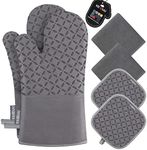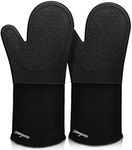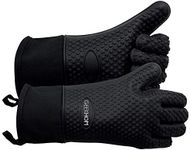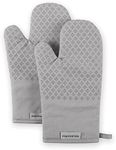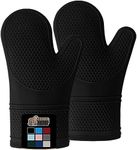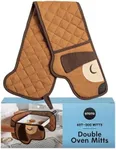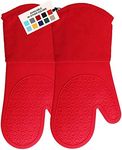Buying Guide for the Best Oven Mitts
Choosing the right oven mitts is important for both safety and comfort in the kitchen. Oven mitts protect your hands from burns when handling hot cookware, baking trays, or dishes. The best oven mitts will offer a balance of heat resistance, flexibility, grip, and ease of cleaning. When shopping, think about how often you cook or bake, the types of dishes you handle, and your personal preferences for comfort and style.MaterialThe material of oven mitts determines their heat resistance, flexibility, and comfort. Common materials include cotton, silicone, and aramid fibers. Cotton mitts are soft and comfortable but may not offer the highest heat protection. Silicone mitts are highly heat-resistant, waterproof, and provide a good grip, but can be less flexible. Aramid fiber mitts (like those made with Kevlar) offer excellent heat resistance and durability, often used for grilling. If you mostly bake or handle lighter cookware, cotton or silicone may be enough. For grilling or handling very hot items, consider aramid fiber or thick silicone mitts.
Heat ResistanceHeat resistance refers to the maximum temperature the mitts can safely handle. This is usually measured in degrees Fahrenheit or Celsius. Lower heat resistance (up to 400°F/200°C) is suitable for basic baking and cooking. Medium heat resistance (up to 500°F/260°C) is better for frequent oven use or handling cast iron. High heat resistance (above 500°F/260°C) is ideal for grilling or professional use. Choose a level that matches the hottest items you typically handle in your kitchen.
LengthThe length of oven mitts affects how much of your arm is protected. Short mitts cover just the hand and wrist, making them easy to use for quick tasks. Medium-length mitts extend a bit up the forearm, offering more protection for reaching into ovens. Long mitts cover most of the forearm and are best for deep ovens or grilling, where you might reach over hot surfaces. If you often reach into deep ovens or handle large trays, longer mitts are safer. For quick stovetop tasks, shorter mitts may be more convenient.
Grip and TextureGrip and texture refer to how well the mitts help you hold onto hot, slippery, or heavy items. Some mitts have textured surfaces or silicone patterns to improve grip, while others are smooth. Good grip is important to prevent accidents and spills. If you handle heavy or awkward dishes, look for mitts with a non-slip texture. For lighter tasks, grip may be less critical.
Ease of CleaningEase of cleaning is about how simple it is to keep your oven mitts hygienic. Some mitts are machine washable, while others can be wiped clean or are dishwasher safe (especially silicone). If you cook often or handle messy foods, easy-to-clean mitts will save you time and effort. Choose a cleaning method that fits your kitchen habits and how much maintenance you’re willing to do.
Comfort and FitComfort and fit determine how easy and pleasant the mitts are to wear. Some mitts are thick and bulky, which can reduce dexterity, while others are more flexible and form-fitting. If you need to handle small items or want more control, look for mitts that are flexible and fit your hand well. For maximum protection, you might prefer thicker, more padded mitts, even if they are a bit bulkier.
